Keeping wild animals captive can result in threats to public safety, inhumane conditions for the animals, and stress for wildlife professionals.
By Molly Kirk/DWR
A juvenile fox in a living room, playing with a toddler. An opossum dressed in pajamas, sleeping in a bed. A mature bobcat living in an enclosure under a deck. An unhealthy, emotionally traumatized bear cub exhibiting an extreme stress response and scratching on neighborhood doors in search of food and comfort. A young whitetail buck that was domesticated on a farm wandering around a neighborhood with painted hooves, approaching and trying to mount people.
The wildlife biologists at the Virginia Department of Wildlife Resources (DWR) can tell story after story of discovering animals such as raccoons, opossums, foxes, deer, coyotes, bobcats, and bears living in completely inappropriate situations as captive wildlife.
Possessing captive wildlife without a permit is generally illegal in Virginia. According to administrative code, “It is unlawful to take, possess, import, cause to be imported, export, cause to be exported, buy, sell, offer for sale, or liberate within the Commonwealth any wild animals unless otherwise specifically permitted by law or regulation.” (4 VAC 15-30-10).
But the actual consequences of a person taking wildlife out of their natural habitat and into his or her possession extend far beyond the legality of the action. Bringing a wild animal into a domestic setting, or domesticating a wild animal in any way, jeopardizes the health and safety not only of the animal, but also of the persons keeping the animal captive and their community. In many cases, the possession of a wild animal may lead to the animal’s death.
It’s a hard reality that most wild animals that have been taken captive need to be humanely euthanized, or dispatched, after confiscation, whether for disease concerns or health issues or to ensure public safety. There are few safe, healthy options for formerly captive wildlife. It becomes an emotionally fraught situation for both the captors of the animals and the wildlife professionals confiscating them.
“These animals did absolutely nothing wrong, but when people take it upon themselves to keep these animals as pets, the wildlife always loses,” said Justin Folks, DWR’s deer project leader. “It seems as if some people feel like it’s their duty or obligation to care for wild animals. There are a lot of people that will try to help wildlife that doesn’t need help. They’re well intentioned. But more often than not, the best thing to do for wildlife is to just leave the animal alone.”
Sometimes, people come across an injured wild animal and take it home in an effort to help. Baby animals are often taken captive, as they seem defenseless and possibly orphaned. Occasionally, people trap wildlife with the specific intent to take the animals captive. No matter the intent, removing a wild animal from their native environment is not only illegal, but also inhumane and unfair to the animal.
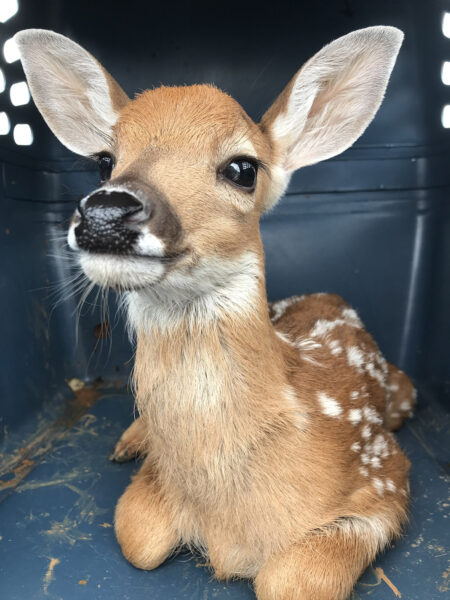
Taking young animals, such as fawns, into captivity does a disservice to the animal and the community. Photo by Jordan Green/DWR
While DWR doesn’t keep records on how many captive wildlife confiscations happen each year in a state-wide database, in 2023, DWR dispatch received 189 calls about captive wildlife. “I just started my 35th year working for the agency, and it does seem like it is increasing in frequency as to either wildlife being held, or wildlife being marked as pets and released,” said Fred Frenzel, DWR district wildlife biologist.
Captivity is Unfair to Wildlife and Communities
A wild animal held captive, especially one that’s captured at a very young age, loses its ability to function effectively in the wild. It becomes habituated to people, losing their instinctive fear of humans. The animal also can associate humans with food, which causes it to seek out human contact, often in a persistent or dangerous way or in a way that can be perceived as aggressive.
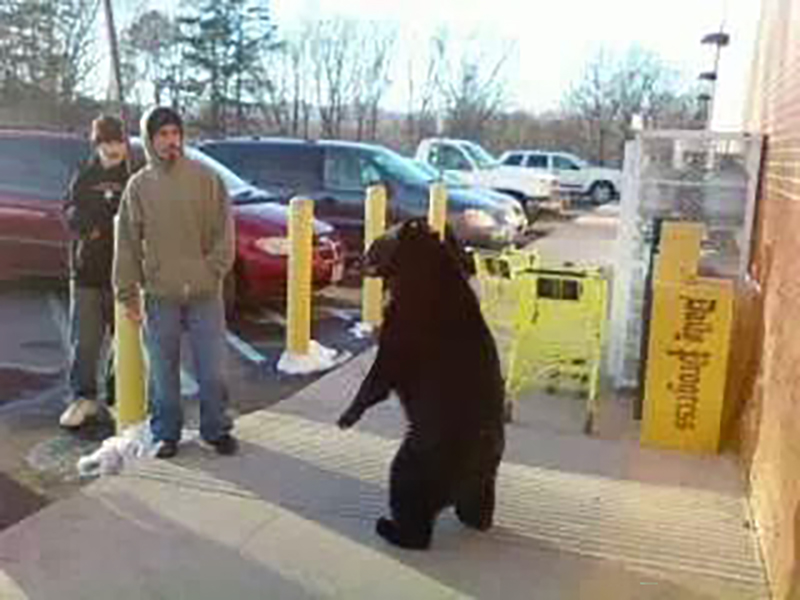
When wild animals lose their fear of humans, dangerous human-wildlife interactions can result.
“That animal has learned that a person can give them food, and they can get all their needs met by a person,” said Katie Martin, DWR deer, bear, and turkey biologist. “The odds for most of those animals going back to foraging for themselves once they’re released back into the wild are slim.”
Wild animals that have been food conditioned and/or habituated to human contact are also much more likely to cause physical harm to people, whether it’s a bite or through the trans-mission of disease or parasites. That cute, wide-eyed fawn that looked so harmless and helpless can mature into a hormone-filled juvenile buck wielding antlers in just a few years’ time. Deer goring or kicking humans have made national news recently in Utah, New Jersey, Florida, and more. Deer are not inherently aggressive toward humans. But if they’ve been conditioned to human contact—and especially if they view humans as providing food sources—they can behave aggressively. DWR wildlife biologists and Conservation Police Officers (CPOs) receive many reports every year of “tamed” white-tailed deer approaching and injuring people and pets while out walking dogs, gardening, or otherwise enjoying the outdoors.
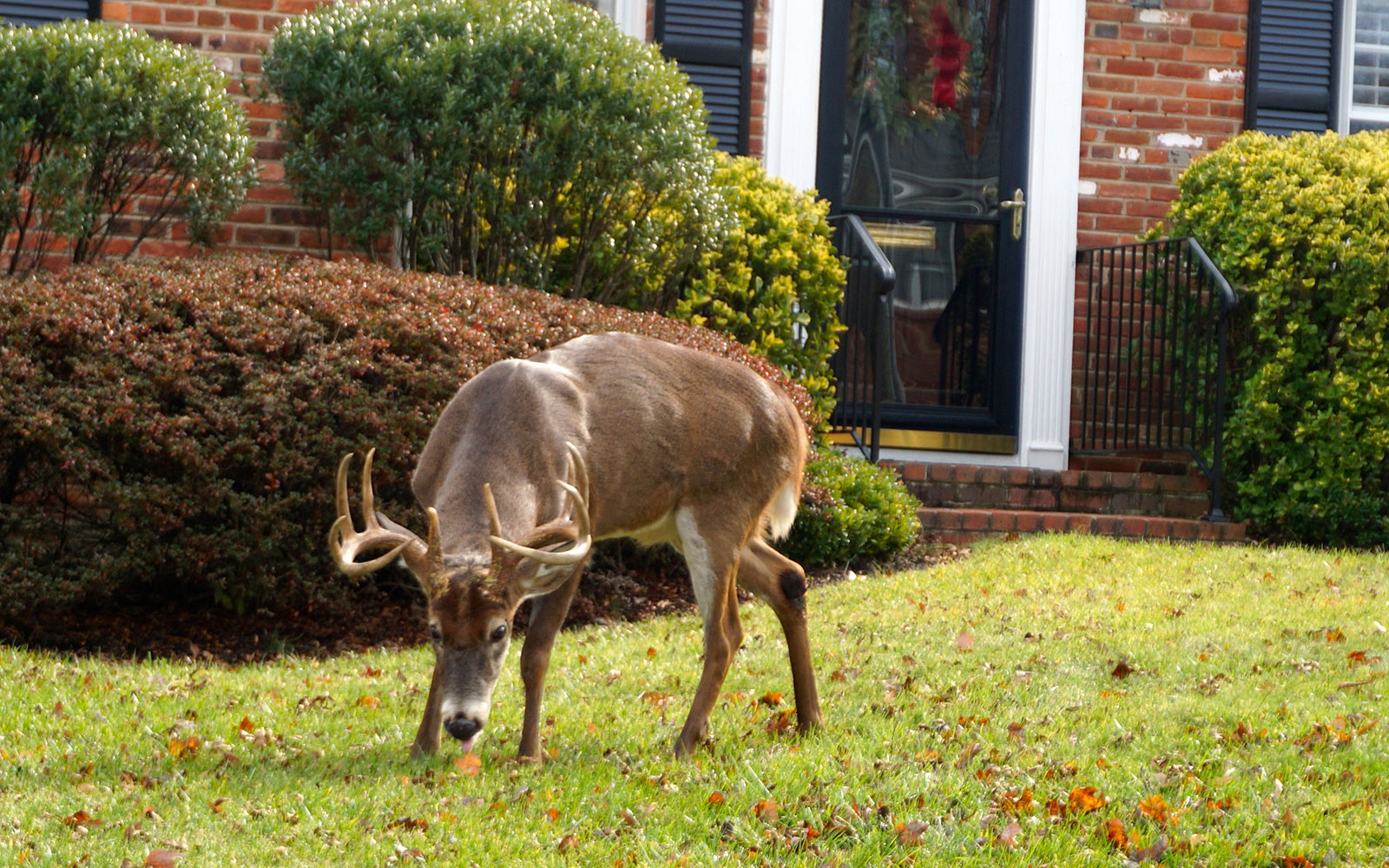
Wild animals that have been “tamed” and have become accustomed to human contact can pose a threat to humans and pets./ Photo by Shutterstock
In many cases, the consequences of feeding or otherwise habituating an animal can impact people beyond the person who initially made contact with the animal. “I’ve had a couple of recent cases where young bucks have headbutted children because they’ve been tamed by someone who then let them loose,” said Folks. “When that buck gets older, grows antlers, and is full of testosterone during the rut, that animal can do a lot more damage, or even kill somebody. Any time we get a report of a tame or captive animal, we have to take it seriously. We’re looking out for the public good.” The threats are just as ominous when a 300-pound bear that’s been fed by humans starts breaking into neighborhood houses in search of food because the bear learned to associate humans and houses with easily acquired sustenance.
It’s a threat to public safety to release a wild animal that’s lost its fear or wariness of humans back into the wild. So, in most cases, especially with deer and bears, humane dispatch is the only way to ensure that the animal doesn’t harm a human in the future.
The Threat of Disease
Virginia’s deer population has been affected by Chronic Wasting Disease (CWD), a contagious, fatal prion disease in cervid (antlered) animals that’s spread by direct contact of an infected deer with a healthy deer when contaminated body fluids enter the healthy deer’s system or via indirect exposure by coming into contact with the prion in the environment. So far, CWD has only been identified in deer in certain areas in Virginia. DWR’s efforts to slow and limit the spread of CWD includes preventing movement of deer/prions across the landscape and contact between deer from different populations in Virginia as much as possible. So, releasing captive (and possibly CWD-positive) deer into other locations isn’t possible. Contrary to public sentiment, Virginia does not have wildlife “refuges” or “sanctuaries.”
Deer that are marked “pet,” wearing a collar or other item marking them in an attempt to protect them, also require removal by wildlife biologists. “They’re just putting a bullseye on the deer because now we’ve got to assume that deer is tame, and we don’t know if the animal came from another state or county,” said Folks. “Then we have to get the deer off the landscape so that someone doesn’t get hurt or that animal doesn’t spread disease to our native wildlife.”
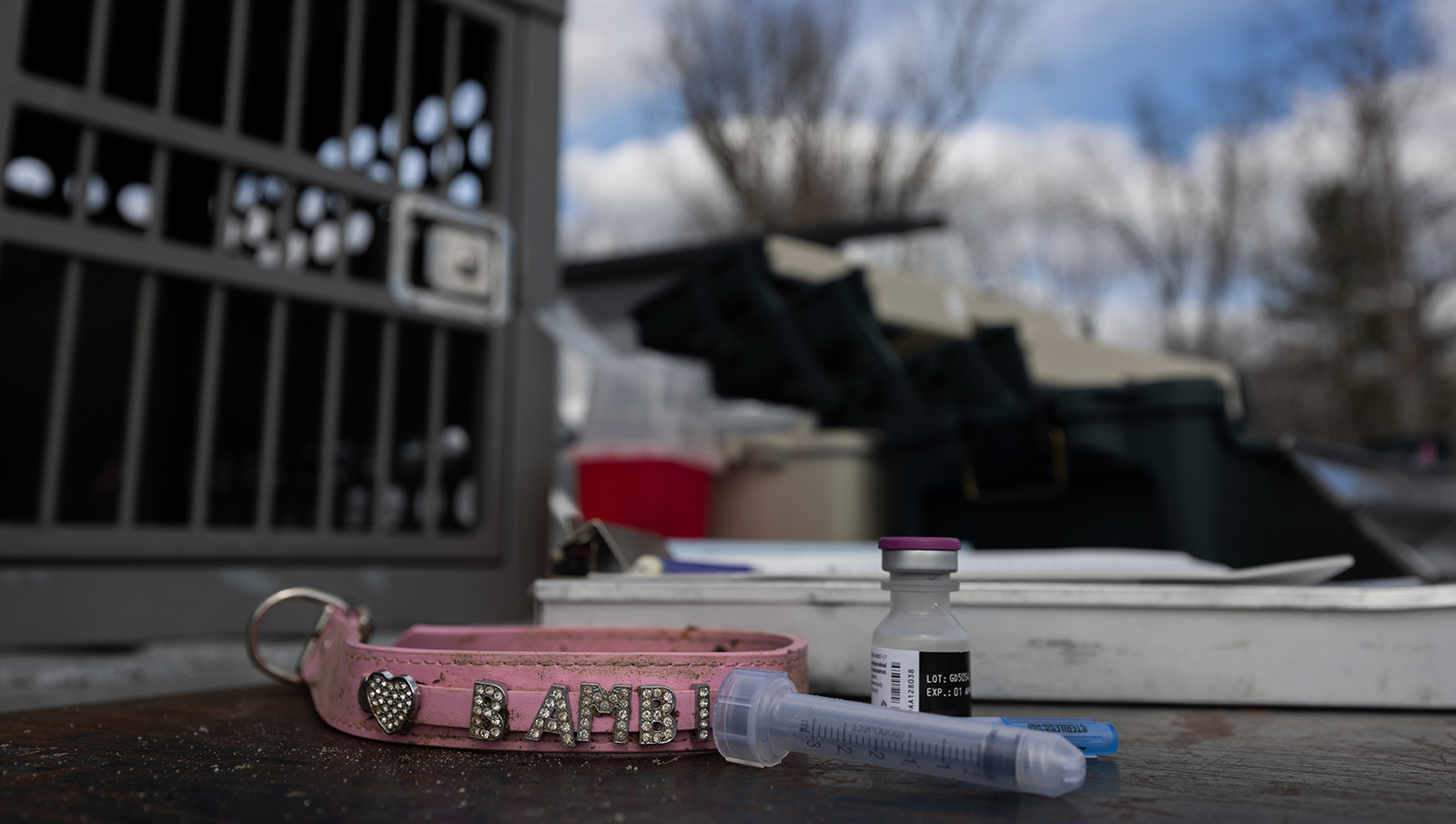
Marking a deer as a pet with a collar alerts wildlife biologists that the animal needs to be removed from the landscape. Photo by Meghan Marchetti/DWR
In addition, putting wildlife in contact with humans leads to a variety of disease concerns for people. Mange, internal parasites, and tick-borne diseases are also prevalent, communicable disease risks. Raccoons, a common species kept illegally captive, are known carriers of rabies, a disease that is fatal if untreated in humans.
For animals that might carry rabies, the Virginia Department of Health (VDH) decides whether a captive animal that had been in contact with humans needs to be tested for rabies—testing that requires humanely dispatching the animal. “If the VDH determines that an animal needs to be tested for rabies, we have no choice,” said Jaime Sajecki, a regional wildlife manager for DWR. “Sometimes when people ask us what’s going to happen after an animal is confiscated, we’re not lying when we say we don’t know, because it’s up to the VDH to make a determination after speaking with the individual(s) that have kept the animal. This conversation and determination may not happen until after the animal is removed from the home or property.”
Unintentional Inhumane Conditions
While keeping a wild animal captive might fulfill a human’s need to nurture, it’s difficult for a domestic environment and untrained people to meet the animal’s physical and behavioral needs, in particular their nutrition. DWR biologists have stories of discovering animals that are grossly overweight or underweight and suffering from health and behavioral problems. While a wild animal will certainly eat a steady diet of a commercial human food, it’s not healthy for them, and they can become chronically and irreparably ill.
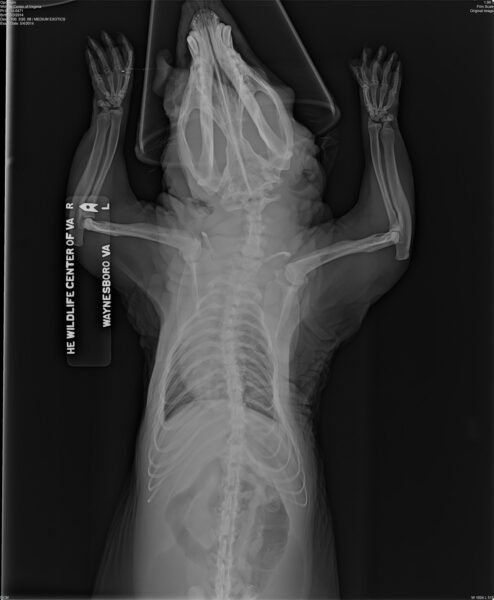
This x-ray of an opossum that had been kept captive shows bone abnormalities—curvature in the legs and spine—that often happen when captive animals are fed inappropriate diets by untrained individuals. Courtesy of The Wildlife Center of Virginia
David Garst, a DWR district wildlife biologist, recalled a raccoon he was called to confiscate. He found the animal lounging on the porch of a house and quickly determined the raccoon was not only overweight at about 35 pounds, but also blind. “I asked her, ‘What have you been feeding this raccoon?’ And she said, ‘He really likes Captain Crunch and honey buns.’ They fed this poor raccoon so much Captain Crunch and honeybuns that he had gone into diabetic acidosis and gone blind. This is why you don’t feed wildlife. Honey buns and Captain Crunch aren’t good for you and me, much less raccoons. Let the raccoons stay wild and go to the river and catch crayfish.”
Captivity can also affect the wild animals’ behavior, as it isolates them from their normal interactions with their own species and others. Jordan Green, also a DWR district wildlife biologist, once encountered a white-tailed fawn that had been living in the basement of a townhouse. “The woman told us that the one time they did try to get the deer to go outside in the back yard while other deer were out there, the deer didn’t even recognize her own kind and ran back inside, terrified,” said Green.
The wildlife biologists who deal with these situations acknowledge that those keeping wildlife captive usually, but not always, have good intentions. “I think we all know that most of the people that take these animals really mean no harm,” said Martin. “The person that picked up that animal and took them home probably wanted to do what they thought was the best thing. They wanted to save the animal, and that we all understand.” But the damage —physical or behavioral—done to the animal by captivity can prevent them from being released back into the wild.
Other Options
If an animal can have a healthy, happy future beyond captivity in a home, DWR wildlife biologists will make efforts to find that avenue. But they’re few and far between. If the animal hasn’t been habituated to people, especially if the animal is young, it’s possible that a permitted wildlife rehabilitation facility could ensure the animal’s health and capability for survival in its native habitat, then release them back into the wild. But that’s not an option for animals that have been kept long-term, aren’t healthy, or have had too much behavioral or developmental damage.
Sometimes, confiscated captive wildlife may be able to fill roles as permitted education animals with organizations or zoos that specialize in native Virginia species and provide appropriate messaging and care. “We don’t have that many facilities in the state that are accredited or otherwise permitted for caring for wildlife,” said Sajecki.
“The living conditions and messaging to the public about the importance of native wildlife and why a particular animal is not in the wild are really important,” Sajecki continued. “That eliminates so many places, including the facilities in Virginia many would classify as roadside zoos or exotic menageries. An education animal has to be healthy, trust and accept their handler, be generally comfortable around people, and not show behavioral signs of emotional distress. The fit has to be just right for the animal and the facility, and that sadly doesn’t happen too often.”
The Toll it Takes
The confiscation of a wild animal that’s been held captive is often a very emotional and upsetting experience for the captor. CPOs, part of DWR’s Law Enforcement Division, always accompany wildlife biologists to confiscations of captive wildlife partly because anger and threats are frequent responses. One CPO was called “Satan with a badge” for assisting with a confiscation. Biologists are often told that they don’t know anything about wildlife as well as being called heartless murderers.
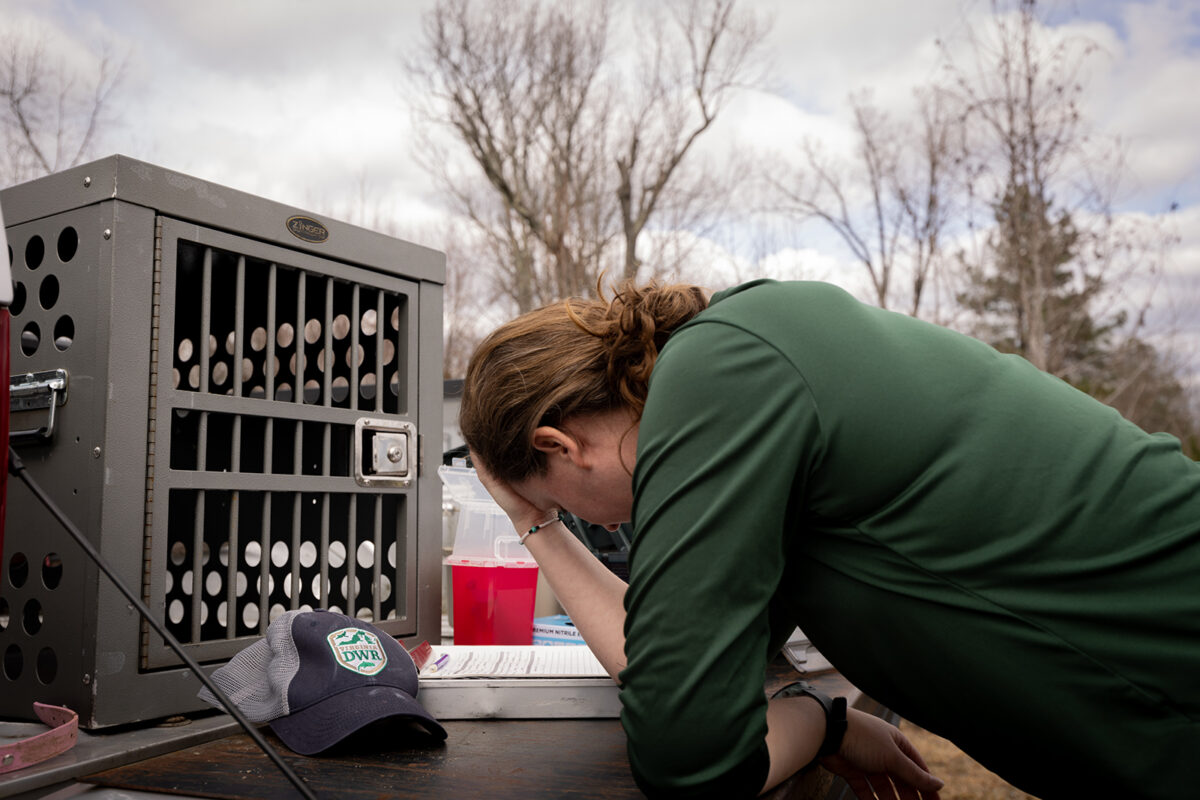
The process of confiscating and dispatching animals that have been held captive can be difficult emotionally for wildlife biologists. Photo by Meghan Marchetti/DWR
But the confiscation, and especially the dispatching, take a substantial toll on the wildlife biologists as well. “As you pull up to a house where an animal is allegedly being held, you never know what you will find behind closed doors,” said Joe Ferdinandsen, DWR district wildlife biologist. “Emotions are running so high. You put your head down and you do what you need to do, but you really think about it later.”
“The angry people are almost easier than the people that are sad,” noted Frenzel. “Wildlife should not be kept as pets, but in their mind, that animal is their pet. They get upset. And that affects me. I didn’t get into this job to go into somebody’s house and take an animal and make people cry. I thoroughly despise that part of the job.”
Most wildlife biologists became interested in the field in order to help populations thrive and be an advocate for wildlife species and habitats. And, while captive wildlife confiscation and humane dispatch have become a significant portion of their role, they often don’t receive formal training in handling the human aspect of captive wildlife situations while earning their degrees or certification.
“When I wanted to become a district biologist, this wasn’t even on my radar as far as duties you’d have to deal with,” said Folks. “We all just care about wildlife. It’s a very traumatic experience to put an animal down. People don’t understand the toll that it can take on the biologists. Then we have to deal with getting yelled at when we’re just doing our job, and a part of our job that we hate.”
“This is the kind of activity that really wears on people in the wildlife profession,” said Sajecki. “There’s a lot of sadness and other emotions that keep people up at night. You can put it in a box in the back of your mind while you’re doing it. But it doesn’t always stay there hidden away. Sometimes we come off seeming like uncompassionate monsters when really, I think when we have to do these things, we have our own coping mechanism that often presents as cold or heartless. But later, when you’re home, it can all rise to the surface as a set of emotions different for every person. You have to come to terms with what happened and deal with it constructively.”
DWR’s wildlife biologists have an informal support system amongst their peers to help them share stories and the burden of the tasks they face while confiscating captive wildlife. “The personal decision for me to become a manager with DWR was to advocate for and pro-vide acknowledgement of the difficulty of these tasks that sets biologists apart from other staff in the agency. Knowing that others in your same position, as well as DWR leadership, understand without explanation, how terrible this part of the job is really helps,” said Sajecki.
A Specific Process to Protect
Although they dislike the process and reasons for the confiscation of captive wildlife, DWR wildlife biologists are prepared for the logistics of the task.
“We all have to go through firearms certification, drug certification, and annual training,” said Martin. “So those of us that are going to handle an animal, capture and/or have to put it down do it in the most humane way possible for the animal.”
DWR’s Wildlife Health section has established a set of best practice protocols for the capture and confiscation of each species, which includes a rubric for whether the animal is a candidate to be ethically released back into the wild or not. There are also defined guidelines on animal welfare and the acceptable forms of humane dispatch that rely in part on the DWR Veterinarian, the American Veterinary Medical Association (AVMA) standards, and Global Wildlife Resources capture and handling training. The procedures ensure that the animal is handled humanely and with respect at each stage of the process.
Every DWR wildlife biologist or other employee that may come in contact with a wild animal that’s a potential rabies carrier during a confiscation is required to go through a pre-exposure rabies vaccination series and get tested regularly to ensure their immunity.
It’s also part of DWR protocol to have a CPO accompany a biologist to a confiscation in order to procure and carry out search warrants, ensure the safety of all involved, explain the illegality of captive wildlife to the captor, and issue citations if deemed appropriate.
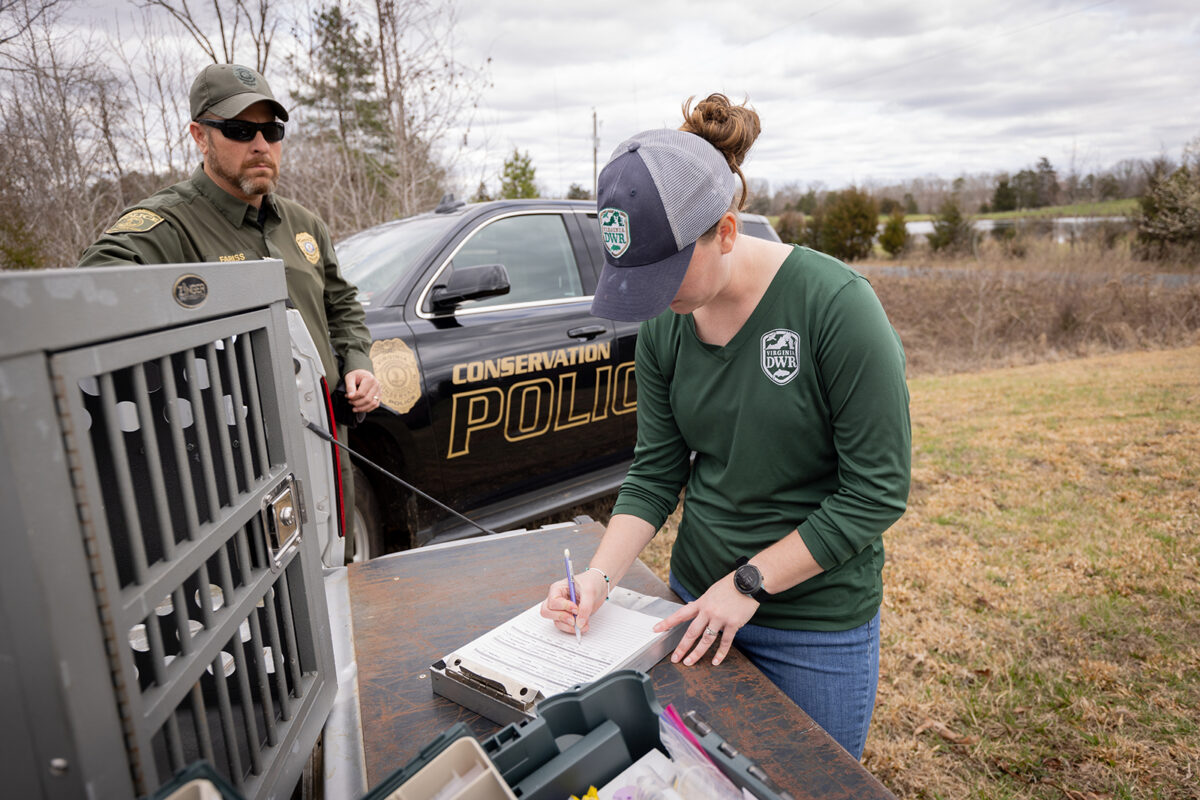
DWR has a well-defined set of protocols for confiscating captive wildlife. Photo by Meghan Marchetti/DWR
What You Can Do
The message biologists want to share with the public is to leave wildlife alone in most cases, even if you are worried about the animal’s welfare or think it is abandoned or orphaned. If you feel the need to take action, contact DWR’s Wildlife Conflict Helpline or a DWR-permitted wildlife rehabilitator to determine appropriate steps before removing a wild animal from the wild. Citizens are allowed to transport wildlife to permitted wildlife rehabilitators.
If you have found a wild animal that’s genuinely abandoned and under one year of age, there is a good chance that animal can be rehabilitated by a permitted individual or organization, but not if that animal grows up in a cage in your basement.
“Leaving the animal alone and then contacting a permitted rehabber or DWR is actually the best thing to do and your best chance for saving the animal versus taking them home and making them a pet,” said Martin. “If you contact us first, there are options to help the animal. It’s once you’ve kept an animal for six months that we don’t have a lot of options.
“We want you to appreciate wildlife. I want every person to love seeing a deer, a bear, a raccoon out in the wild,” Martin continued. “But you don’t need to go hold them, hug them, bring them into your home, or feed them. Wild animals are meant to live in the wild. So please just leave them out there.”
Molly Kirk, the editor of Virginia Wildlife, helped DWR wildlife staff including Justin Folks, Joe Ferdinandsen, Fred Frenzel, David Garst, Jordan Green, Katie Martin, Jaime Sajecki, and others put this article together.
Resources for Wildlife
- Information about Injured or Orphaned Wildlife
- DWR’s Wildlife Conflict Helpline: 855-571-9003 or vawildlifeconflict@aphis.usda.gov
- Permitted Wildlife Rehabilitators
We Can’t Own Wildlife
The Virginia Department of Wildlife Resources (DWR) operates in alignment with the North American Model of Wildlife Conservation—a system of policies and laws to restore and safeguard fish and wildlife populations and their habitats through sound science and active management. This model has in practice helped populations recover and to prevent nonethical practices such as deer “farms” and “shooting preserves” in many states.
In the United States and Canada, the Model operates on interdependent principles that include:
- Wildlife resources are conserved and held in trust for all citizens.
- Wildlife is allocated according to democratic rule of law.
- Wildlife may only be killed for a legitimate, non-frivolous purpose.
- Scientific management is the proper means for wildlife conservation.
According to the Model, Virginia’s wildlife is a shared resource that belongs to all Virginia residents, and individual wildlife animals cannot be owned or possessed by one person. “Merriam Webster defines ‘poach’ as ‘to take (game or fish) by illegal methods,’” said Justin Folks, DWR deer project leader. “I think if you asked the people who kept a wild animal as a pet what they thought about poachers, they’d tell you they despise them. But possessing a live, wild deer is no different than someone shooting a deer at night from a truck window.” Both of those actions are removing the public’s ability to see, appreciate, or harvest that animal, so both can be considered poaching.
Population vs. Individual
The average Virginia wildlife enthusiast might see wild animals as individuals, and those who take wildlife into captivity—naming them, feeding them, clothing them, sleeping in bed with them—definitely see the animal as an individual. So, the survival of one specific wild animal takes on an importance for that person, who has falsely claimed ownership.
Because wildlife biologists have historically been professionally trained to see wildlife as populations, not individuals, the loss of one animal of a thriving species isn’t a tragedy in the context of population health. In fact, it’s part of the natural cycle of life. However, the significance of individuals is important when it comes to humane treatment, welfare, and denial of natural behaviors/opportunities. Animal welfare is an important goal in the wildlife profession. For the first time in one of its species management plans, DWR has included the welfare of bears (e.g., addressing orphan bear cubs, the handling of bears with severe mange infections) as a stated goal in the newly implemented 2023–2032 Virginia Black Bear Management Plan.
Many tasks that wildlife biologists perform are for the welfare of an individual, such as humanely euthanizing an animal that is suffering from a terrible incurable disease or severe injury. Most of the species that are commonly taken captive—white-tailed deer, raccoons, opossums, black bears—are species that are thriving in great numbers across the Commonwealth.
But when a biologist has to remove a pair of pajamas from an opossum before then removing the animal’s head to send to the VDH for testing, the grief and frustration isn’t about the overall health of a population, but about the individual animal that did nothing wrong to warrant this outcome.

